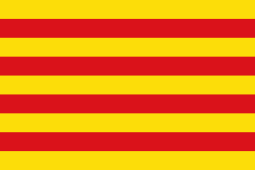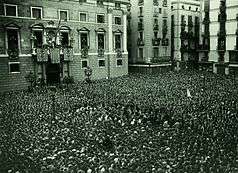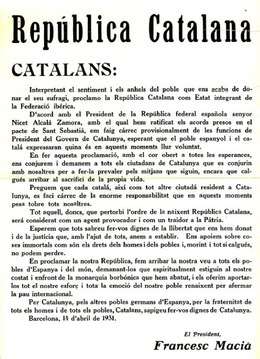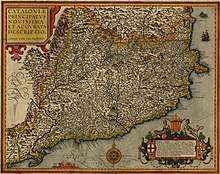Catalan Republic (1931)
The Catalan Republic (Catalan: República Catalana, IPA: [rəˈpubːlikə kətəˈlanə]) was a state proclaimed in 1931 by Francesc Macià as the "Catalan Republic within the Iberian Federation",[2][3] in the context of the proclamation of the Second Spanish Republic. It was proclaimed on 14 April 1931, and superseded on 17 April by the Generalitat de Catalunya, the autonomous Catalan government.[4]
Catalan Republic | |||||||||||
|---|---|---|---|---|---|---|---|---|---|---|---|
| 1931–1931 | |||||||||||
 Flag | |||||||||||
 Location of the Catalan Republic within Europe | |||||||||||
| Status | Republic within Iberian Federation | ||||||||||
| Capital | Barcelona (de facto) | ||||||||||
| Common languages | |||||||||||
| Demonym(s) | Catalan | ||||||||||
| Government | Unitary republic under provisional government | ||||||||||
| President | |||||||||||
• 1931 | Francesc Macià | ||||||||||
| Historical era | Interwar period | ||||||||||
• Proclaimed | 14 April 1931 | ||||||||||
• Establishment of the Generalitat | 17 April 1931 | ||||||||||
| |||||||||||
| Today part of | ∟ | ||||||||||
History


After the Dictatorship of Primo de Rivera, Spanish republican parties agreed through the Pact of San Sebastián (17 August 1930) to prepare for a change of regime in case of victories in upcoming elections. In this project, there was a provision for the political autonomy of Catalonia, within the Spanish Republic. On 12 April 1931, local elections gave a large and unexpected majority in Catalonia (including Barcelona) to the Republican Left of Catalonia[5] (Catalan: Esquerra Republicana de Catalunya, ERC), a party that had been founded three weeks earlier by the union of the independentist Estat Català and the Catalan Republican Party. Two days later (14 April), few hours before the proclamation of the Second Spanish Republic in Madrid, ERC's leader, Francesc Macià, proclaimed the "Catalan Republic" from the balcony of the Palace of the Generalitat (then the seat of the Provincial Deputation of Barcelona), "expecting that the other peoples of Spain would constitute themselves as republics, in order to establish an Iberian Confederation".[6] The proclamation of Macià was preceded by a proclamation of the Spanish Republic by another ERC member, Lluís Companys, from the balcony of the City Hall, and the Spanish and Catalan Republican flags were hoisted from the balcony.[7][8] Francesc Macià proclaimed himself president of Catalonia,[9] and ratified in this position by the elected councillors of Barcelona.[10]
Macià immediately dismissed General Ignasi Despujol, chief of the Spanish Army in Catalonia, appointing in his place General López Ochoa, who was loyal to the new republican government,[11] while Companys was designated civil governor of Barcelona and Jaume Aiguader became mayor of Barcelona. The jurist Josep Oriol Anguera de Sojo was appointed president of the Territorial Audience of Barcelona[12] (the highest court of justice in Catalonia at the time). Helped by socialist Manuel Serra i Moret, he also appointed the ministers of the Catalan government, dominated by the Republican Left of Catalonia. He included among his ministers a member of the Radical Republican Party, a member of the UGT trade union, a member of Acció Catalana, as well as two representatives from the Socialist Union of Catalonia, but none from the previously hegemonic and conservative Regionalist League. (In the streets many citizens clamored against the leader of the League, chanting "Long live Macià and death to Cambó!").[13] Macià even offered a ministry to the anarchist trade union CNT, but the anarcho-syndicalist organization finally refused to participate, claiming its traditional apoliticism.[14]
The provisional government of the Catalan Republic was made up of:[15]
- President: Francesc Macià (Republican Left of Catalonia)
- Minister of Politics: Ventura Gassol (Republican Left of Catalonia)
- Minister of Instruction: Rafael Campalans (Socialist Union of Catalonia)
- Minister of Defence: Joan Casanovas (Republican Left of Catalonia)
- Minister of the Treasury: Casimir Giralt (Radical Republican Party)
- Minister of Economy and Work: Manuel Serra i Moret (Socialist Union of Catalonia)
- Minister of Communications: Manuel Carrasco i Formiguera (Acció Catalana)
- Minister of Public Works: Salvador Vidal Rosell (Unión General de Trabajadores)
The next steps of the new Catalan Government involved taking control of the territory. It ordered every municipality in Catalonia to ensure the proclamation of the Republic. It also appointed delegates of the government in the provinces of Girona, Lleida and Tarragona. On 15 April, a decree making Catalan the official language was passed.[16] On the same day, Macià signed a decree which allowed freedom of broadcast time to Ràdio Associació de Catalunya.[17]
Three days later (17 April), the government of the new Spanish Republic, concerned about this proclamation and the duality of powers it created, sent three ministers (Fernando de los Ríos, Lluís Nicolau d'Olwer and Marcel·lí Domingo) to Barcelona in order to negotiate with Macià and the Catalan Government. Macià reached an agreement with the three ministers,[18] in which the Catalan Republic was renamed the Generalitat of Catalonia (Catalan: Generalitat de Catalunya), becoming an autonomous government within the Spanish Republic,[19][20] that would be granted a Statute of Autonomy after the elections for Spain's Parliament (Cortes Generales).[21] Francesc Macià would become the President of the Generalitat of Catalonia (as acting until November 1932, when he was elected by the Parliament of Catalonia), a position he held until his death on 25 December 1933.[22]
See also
Part of a series on the |
|---|
| History of Catalonia |
 |
|
|
|
|
|
By topic
|
| Timeline |
References
- Torra, Quim (15 April 2012). "Una República Catalana que governa". El Punt Avui (in Catalan). Retrieved 3 November 2017.
- "Spain: Macià's Catalonia". Time. 20 June 1932.
- Esculies, Joan (October 2012). "El cavaller de l'ideal". Sàpiens. 121: 22–28.
- "República Catalana". enciclopèdia.cat. Retrieved 6 October 2019.
- Soler Becerro, Raimon. Les eleccions municipals de 1934 a Catalunya. Apèndix 1: Les eleccions municipals de 1931.
- Juliá, Santos (2009). La Constitución de 1931. Lustel, Madrid pp. 31-32 ISBN 978-84-9890-083-5
- "Edición del miércoles, 15 abril 1931, página 6". La Vanguardia: 6. 15 April 1931. Retrieved 2 October 2019.
- "Edición del jueves, 16 abril 1931, página 1". La Vanguardia: 1. 16 April 1931. Retrieved 6 October 2019.
- Stone, Peter (2007). Frommer's Barcelona. John Wiley & Sons. p. 311. ISBN 0470096926. Retrieved 4 October 2019.
- Pitarch, Ismael E. (September 2009). El president Macià i el Parlament de Catalunya (PDF) (First ed.). Barcelona: Parlament de Catalunya. Departament d'edicions. p. 16. Retrieved 6 October 2019.
- Fontana, Josep (2014). La Formació d'una identitat. Una història de Catalunya. Ed. Eumo. p. 335. ISBN 9788497665261.
- Fontana 2014, p. 336
- Balcells, Albert (2006). «El reto de Cataluña». La Aventura de la Historia (15). ISSN 1579-427X.
- De la Granja, José Luis; Beramendi, Justo; Anguera, Pere (2001). La España de los nacionalismos y las autonomías. Madrid: Síntesis. p. 125. ISBN 84-7738-918-7.
- "El Gobierno Provisional de Cataluña". La Vanguardia: 7. 16 April 1931. Retrieved 28 September 2019.
- Bonamusa, Francesc (2006). Generalitat de Catalunya. Obra de govern 1931-1939 vol. 1. Barcelona: Generalitat de Catalunya, Secretaria de Presidència. p. 25. ISBN 9788439373957.
- "Tal dia com avui de 1931, Macià signava com a president de la República Catalana un decret en favor de la llibertat d'emissió de Ràdio Associació". radioassociacio.cat. Retrieved 6 October 2019.
- Mata, Jordi (17 April 2006). "La República dels 3 dies". El Triangle. 775: 36–37.
- Torra, Quim (17 April 2012). "L'últim acte de la República Catalana". El Punt Avui (in Catalan). Retrieved 26 September 2019.
- Carr, Raymond. Modern Spain: 1975-1980. Oxford University Press, 1980, p.xvi.
- Fontana 2014, p. 336
- Fontana 2014, p. 339
Sources and bibliography
- Sobrequés i Callicó, Jaume. Catalunya i la Segona República. Edicions d'Ara (Barcelona, 1983) ISBN 84-248-0793-6
- Pelegrí i Partegàs, Joan. Les primeres 72 hores de la República Catalana. Fundació President Macià (Barcelona, 1993) ISBN 84-604-7580-8
- Roglan, Joaquim. 14 d'abril: la Catalunya republicana (1931-1939). Cossetània Edicions (2006) ISBN 8497912039
- Fontana, Josep (2014). La formació d'una identitat. Una història de Catalunya. Ed. Eumo. ISBN 9788497665261.